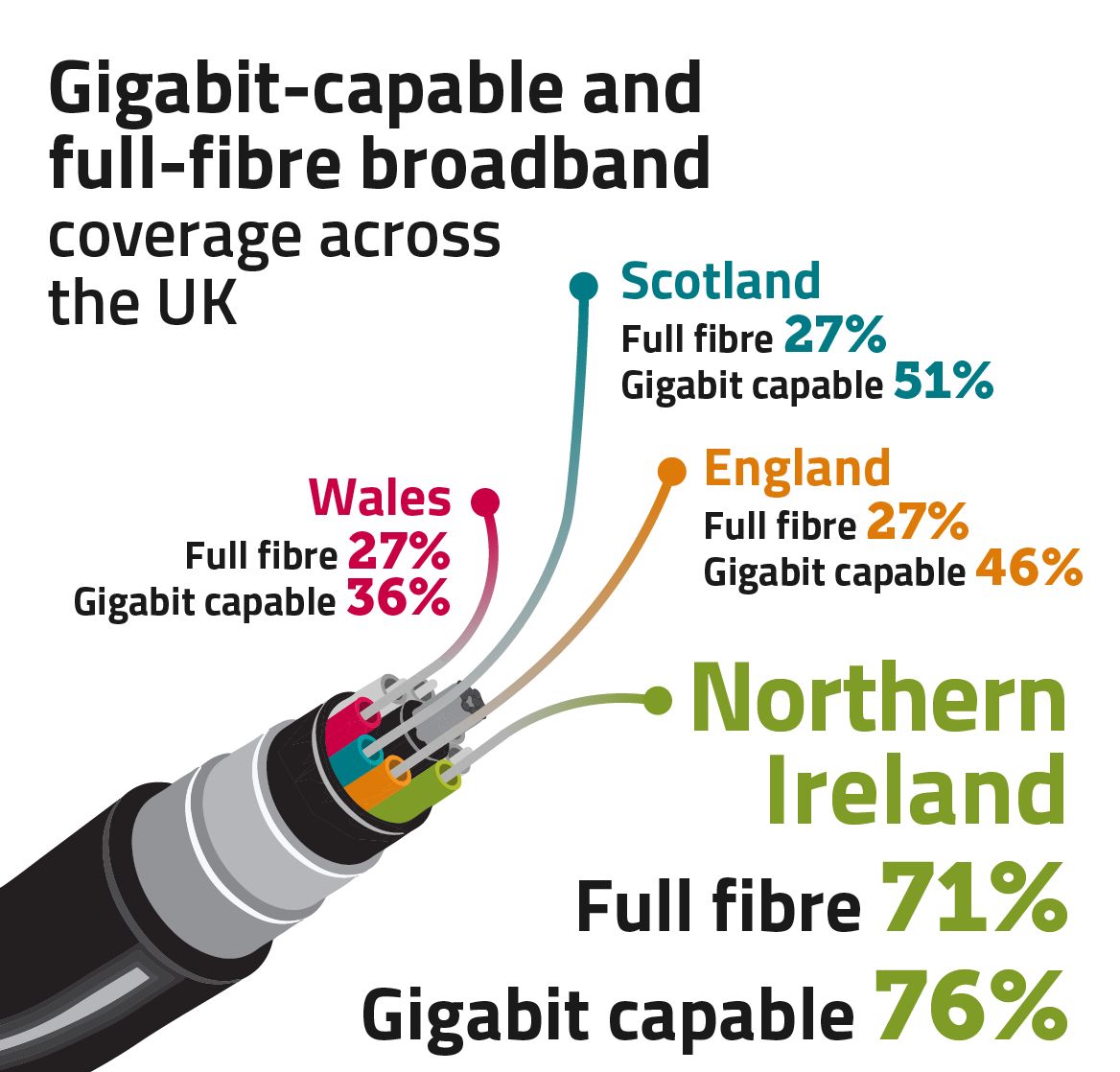
- Full-fibre broadband available to more than half a million homes, as rollout accelerates
- Northern Ireland has the highest availability of full-fibre broadband across the UK
- Properties without access to decent broadband falls to lowest ever level
- Around a quarter of properties in Northern Ireland are now in an area with outdoor 5G coverage
Fast, reliable internet connections are now available to more people than ever before, allowing more than half a million families in Northern Ireland to download their favourite Christmas movie in less than a minute.

Ofcom’s annual Northern Ireland Connected Nations report shows the availability of broadband and mobile services across the UK.
It reveals more than half a million homes in Northern Ireland (539,000) now have access to full-fibre broadband connections; over 116,000 more than last year. These connections can deliver much higher download speeds and are also more reliable than older, copper-based broadband.
Among the four UK nations, Northern Ireland (71%) has the highest availability of full-fibre services, compared to England (27%), Scotland (27%) and Wales (27%).
Northern Ireland’s full fibre position is a result of significant private and publicly funded investment over recent years. Commercial build-out of full-fibre networks has continued apace with Openreach, Virgin Media and Fibrus aggressively expanding their coverage footprints.
The last year has also seen the start of the Northern Ireland Executive’s Project Stratum broadband programme, which is targeting premises with poor broadband, mostly in rural areas.
While Northern Ireland is leading the way on full fibre coverage, there are still significant numbers of homes (45,000) that still don’t have decent broadband from a fixed line. These figures highlight the impact Project Stratum, which is aimed at premises that can’t get superfast speeds, will have and on rural areas especially.
Why would I need full fibre?
Full-fibre connections – along with upgraded cable networks – can deliver download speeds of up to 1 Gbit/s. At this speed, families with full-fibre services could download Christmas film favourite Elfin High-Definition in less than a minute, compared with around 25 minutes for those with superfast broadband (30 Mbit/s).

Full fibre can better support data-hungry households where family members need to stream, work, game, video-call and study online at the same time. And in a year when many people continue to work from home due to the coronavirus pandemic, average monthly data use in Northern Ireland grew to 455 GB per connection - more than treble what it was five years ago (132GB).
Coverage of faster broadband in rural areas is improving
Broadband services and speeds vary across Northern Ireland between urban and rural areas. This is because properties in rural areas tend to be more dispersed and are more expensive to provide new, faster, fixed line broadband services to.
However, there has been significant improvement in the availability of faster broadband services over the last year.
A rise in full fibre coverage is especially evident in several, mainly rural council areas where coverage had previously been very low. So, in Newry Mourne and Down full fibre coverage now extends to some 71% of residential premises, up from just 35% a year ago. Full fibre coverage in Causeway Coast and Glens is now 66%, up from 42% a year ago.
More urban areas too, such as Belfast, Ards and North Down, and Lisburn and Castlereagh have also seen impressive increases in full fibre coverage over the last year.
We expect full fibre coverage in all council areas to continue this upward trend on the back of Project Stratum and ongoing commercially led investments.
It’s very encouraging to see Northern Ireland performing so well on the availability of full-fibre broadband. This technology is crucial in supporting our economy, especially at a time and when more and more of us are working from home.
It’s especially welcome to see more rural areas having access to faster broadband services, a trend that will accelerate over the next few years as the Northern Ireland Executive’s Project Stratum programme gathers pace.
Jonathan Rose, Director Ofcom Northern Ireland
5G coverage revealed
The rollout of 5G continues to make progress, and for the first time we have published 5G coverage data.
We estimate that around a quarter of properties in Northern Ireland are in areas where 5G is available outside from at least one mobile network operator. Across the UK, take-up of 5G-enabled handsets has increased substantially, from just 800,000 last year to more than six million in 2021.
4G coverage has remained largely unchanged over the last year. Individual operators provide good 4G geographic coverage across Northern Ireland, with mobile coverage ranging from 87-92%, depending on the operator. Coverage from all four operators is available across 79% of Northern Ireland.
Coverage is set to improve over the coming years with the implementation of the Shared Rural Network.
Notes to editors
- We estimate that 5G is available from at least one mobile network operator in the vicinity of 22-31% of premises. The range is based on the information provided to us by operators and informed by our own measurement work.
- ‘Decent’ broadband is a service able to deliver a download speed of at least 10 Mbit/s and an upload speed of 1 Mbit/s.
- The number of premises in Northern Ireland unable to get decent broadband from a fixed line was 45,000 in 2021, compared to 49,000 in 2020.
- An interactive version of the report, also published today, allows people to look up how coverage compares in their area.
